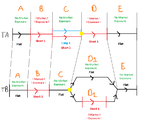alright, well you could describe it unfinalised flat and finalised flat since the first still has an obligation to exit the two trades (same obligation as any trade taken)
the fact remains that the first guy is exiting - he is not taking on any new trade, he is merely exiting both those he has already taken at different times.
You've got to stop thinking about these trades as "entries" and "exits". The effect of the trades is this: they either move you from a position from
No Market Exposure -> Market Exposure
or
Market Exposure -> No Market Exposure
I've made a diagram taking you through the two different approaches.
Look at Trader A's (top line) options at the end of period C - by "exiting" his "long position", he is
entering a period of market exposure. This is
exactly the same as the transition from A -> B (top line), A -> B (bottom line) and C-> D2 (bottom line). Do you see that?
Trader A, by putting the two "positions" on at the end of period B, moved himself from having Market exposure to No Market exposure. HE ALSO MADE IT IMPOSSIBLE TO GET TO THE CLOSE WITHOUT FURTHER MARKET EXPOSURE. He has to close BOTH trades. Granted, he could close both trades simultaneously, and suffer the increased costs as we have covered. He can also choose to go Long or Short, depending on which "position" he "exits".
Trader B, on the other hand, after closing his first positon and going flat, can quite happily make it to the end of the close without doing anything (path D1). He can also, if he chooses, get further Market Exposure by putting on another trade (path D2), either long or short as he see's fit.
Now imagine both traders are trading exactly the same system - a simple MA crossover, for example.
At the Yellow square, both traders get the same signal - time for another short. Trader A "exits" his "long position" (leaving him short 1) and Trader B, having got the same signal (same strategy remember), enters a new position by shorting 1. Both traders are Short 1, they close, and finish the day flat with the same P&L.
Now imagine that, after the first trade, nothing at all happens at the yellow square and the system does not generate any more signals for the rest of the day. Trader B can just sit on his hands (path D1), he has no exposure, he has nothing to worry about. All he's got to do is take the trades when they come along.
Trader A, however,
cannot avoid another period of Market Exposure. (Well, he can, by closing both trades simultaneously and crossing the spread again, but you understand that. I couldn't fit all the options on to the diagram
😛)
This means that, without his strategy giving him any clues (which is all a signal is), he just has to guess.
==========================================================================
Having established how the two traders positions differ, let's examine the implications of that on their P&L.
Let's say that their strategy has an expectancy of 0.3R - that is, it makes 30% of whatever the traders risk*.
Trader B only Exposes himself to the market (lol) when his strategy gives him a signal, and every time that it does, he expects to make 0.3R each and every time.
Trader A also takes every trade that his system generates (they are both on the same system remember), and every time that he does, he also expects to make 0.3R. Trader A, though, also has to make trades when his system is telling him to be flat, because he's got to close out one of his "positions" first (or suffer increased costs).
Without a proven strategy to guide him, these second trades might as well be based on the toss of a coin*.
And, in the very very long run, the profit and loss of these trades is going to cancel out*. So, because he's using exactly the same strategy as Trader A, he's taken every trade that Trader A has for the same P&L.
BUT HE HAS ALSO TAKEN AN EQUAL NUMBER OF RANDOM TRADES. And each random trade cost him comission.
==========================================================================
It is crucial that you understand this last point.
Given two traders following identical strategies with equal proficiency, the trader who includes trades made at random, over enough time, always make less than the trader that doesn't*. If you take away the profits from their system (which they both made), the difference between the two is that Trader B didn't make any random trades, while Trader A did, and had to pay comissions/spread to make them.
Any "edge" that Trader A had, Trader B has too. Any time Trader A sees a trade, Trader B see's it - and takes it as well. Being Trader A basically means you believe that you can
also make money in the long run by trading at random. You can't.
* note to others: alright, I know I'm taking a lot of liberties here, but I'm trying to make is as simple and straightforward as possible. No offence Jon 🙂
